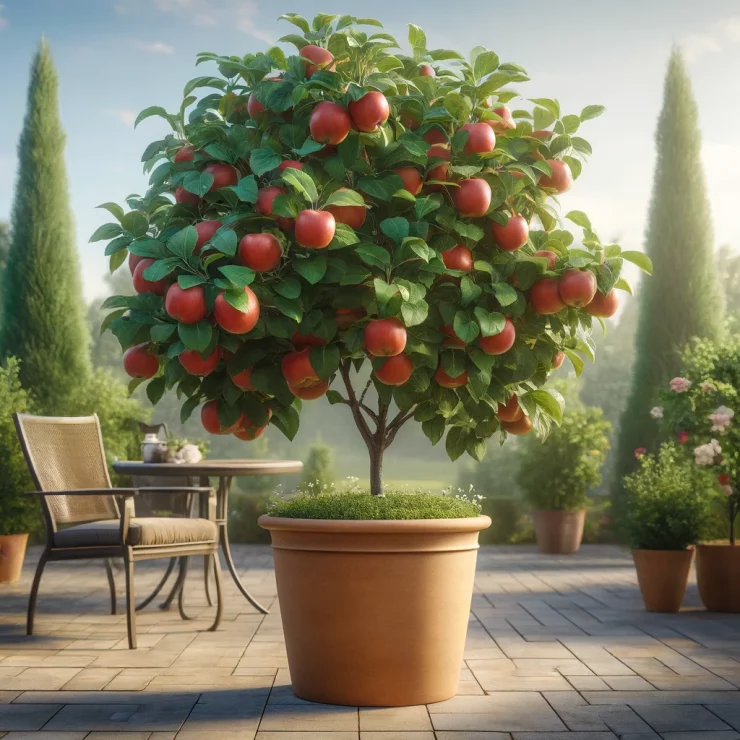Growing an apple tree from seed to fruit indoors is a rewarding and fascinating experience that allows you to witness the entire lifecycle of this beloved fruit tree right in your own home. While growing an apple tree from seed requires time, patience, and careful attention, the process can be incredibly fulfilling for gardeners of all skill levels. In this article, we’ll guide you through the steps to successfully grow an apple tree from seed indoors and eventually enjoy the fruits of your labor.

Step 1: Selecting the Seeds
Start by selecting apple seeds from a variety of apple that you enjoy eating. Keep in mind that apple seeds do not always produce apples identical to the parent tree, as apples are typically grown from grafted trees to maintain specific characteristics. However, growing from seed can still result in unique and interesting apple varieties. Remove the seeds from ripe apples and rinse them thoroughly to remove any pulp or residue.
Step 2: Preparing the Seeds for Planting
To improve germination rates, it’s recommended to stratify the apple seeds before planting. Stratification mimics the natural winter conditions that apple seeds experience before germinating. Place the cleaned seeds in a damp paper towel, then seal them in a plastic bag or container and refrigerate them for 6-8 weeks. Check the seeds periodically to ensure they remain moist but not waterlogged.
Step 3: Planting the Seeds
After stratification, it’s time to plant the apple seeds. Fill small pots or seed trays with a well-draining potting mix, then plant the seeds about half an inch deep in the soil. Water the soil lightly to ensure it’s evenly moist but not saturated. Place the pots in a warm, sunny location or under grow lights to encourage germination.
Step 4: Care and Maintenance
Once the seeds have germinated and seedlings have emerged, provide them with proper care and maintenance. Keep the soil consistently moist but not waterlogged, and ensure the seedlings receive plenty of sunlight or artificial light to promote healthy growth. As the seedlings grow, transplant them into larger pots to accommodate their increasing root systems.
Step 5: Pollination
Indoor-grown apple trees will require assistance with pollination since they won’t have access to outdoor pollinators like bees. To facilitate pollination, gently shake the branches of the apple tree when it begins to flower to help distribute the pollen between flowers. Alternatively, you can use a small paintbrush to transfer pollen between flowers.
Step 6: Pruning and Training
As the apple tree grows, it’s essential to prune and train it to develop a strong and productive structure. Remove any damaged or crossing branches, and prune for shape and size as needed. Consider training the tree using espalier techniques or other methods to maximize space and encourage fruit production in an indoor setting.

Step 7: Fruit Development
With proper care and attention, your indoor-grown apple tree should begin to produce fruit within 3-5 years, although it may take longer depending on the variety and growing conditions. Be patient and continue to provide the tree with adequate water, sunlight, and nutrients to support fruit development. When the apples are ripe, harvest them and enjoy the fruits of your labor!
Growing an apple tree from seed to fruit indoors is a rewarding journey that offers a unique perspective on the lifecycle of this iconic fruit tree. By following these steps and providing the proper care and attention, you can successfully grow your own indoor apple tree and experience the joy of harvesting homegrown apples right in your own home. Whether you’re a seasoned gardener or a novice enthusiast, growing an apple tree from seed is a fulfilling and educational experience that will leave you with a newfound appreciation for the wonders of nature.
News
JJ Redick reacts to Luka Doncic trade for Anthony Davis
In one of the most jaw-dropping moves of the season, the NBA landscape was rocked by the blockbuster trade involving Luka Dončić and Anthony Davis—a swap that has sent ripples of excitement, disbelief, and heated discussion through the league. Among…
Anthony Davis FULL reaction to trade to Mavericks for Luka Doncic
In a blockbuster move that sent shockwaves through the NBA and left fans reeling, Anthony Davis has been traded to the Dallas Mavericks in exchange for Luka Dončić. In the immediate aftermath of the news, Davis took to the media…
Shaq reacts to Dallas Mavericks wanting Kevin Durant after Luka-AD trade 👀
In the constantly shifting world of the NBA, trade rumors and blockbuster moves are a regular part of the season’s drama. The latest twist has fans buzzing: the Dallas Mavericks have reportedly set their sights on acquiring Kevin Durant in…
Donovan Mitchell FILTHY poster dunk on Kristaps Porzingis 😳
In a game filled with high-intensity moments and jaw-dropping highlights, one play in particular has left fans and analysts buzzing about Donovan Mitchell’s latest display of athleticism. Early in the contest, with the atmosphere already charged by an evenly matched…
Joel Embiid hits go-ahead bucket vs Mavs then chats with Anthony Davis after game
In one of the most thrilling contests of the season, Joel Embiid delivered a clutch performance against the Dallas Mavericks, punctuating the game with a go-ahead bucket that sent the home crowd into a frenzy. The atmosphere in the arena…
D’Angelo Russell game winner as Nets hit two 3’s in 3 seconds to win vs Rockets 😱
In one of the most electrifying moments in recent NBA history, D’Angelo Russell delivered an unforgettable game-winner that left fans and commentators in complete awe. With the Brooklyn Nets locked in a tense battle against the Houston Rockets, the outcome…
End of content
No more pages to load











